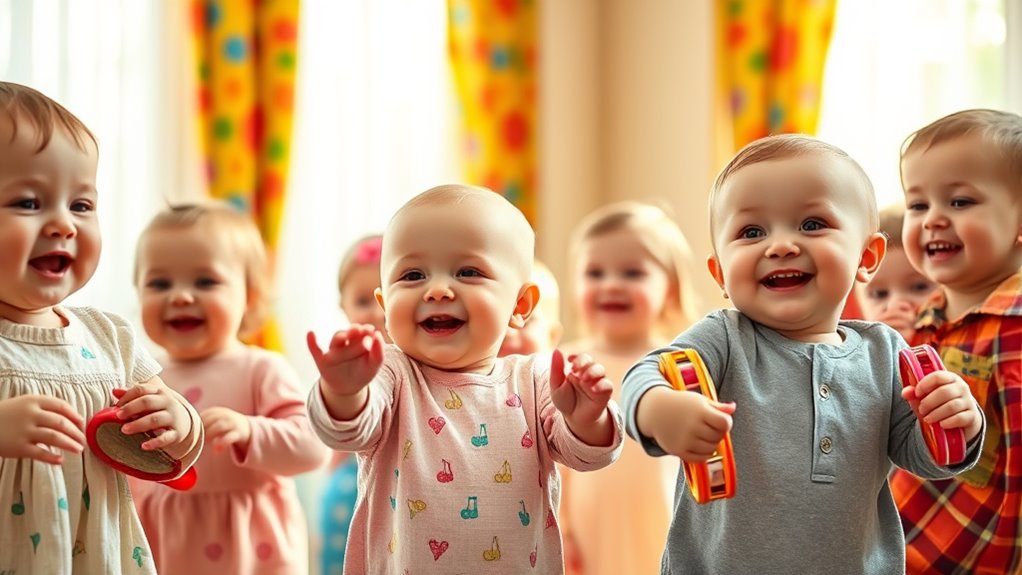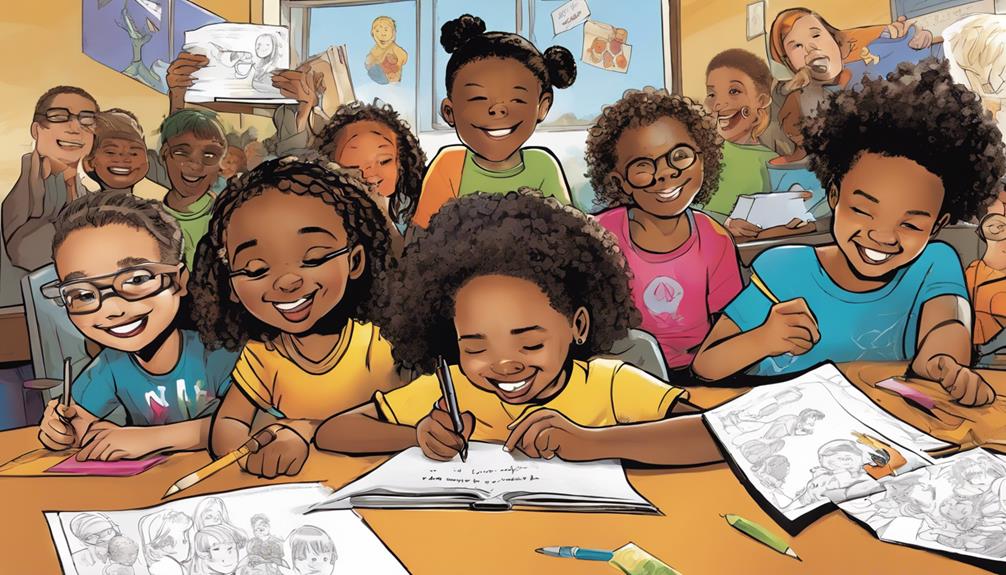Engaging your baby with lively songs and simple dance moves benefits their early development by boosting senses, coordination, and emotional growth. Songs like “The Wheels on the Bus” or “If You’re Happy and You Know It” invite movement and interaction, strengthening bonds and building confidence. Incorporate fun rhythms, homemade instruments, and routines to keep things safe and enjoyable. Keep exploring these ideas to create joyful, active moments that nurture your baby’s growth and love for music.
Key Takeaways
- Use simple, lively songs like “The Wheels on the Bus” to encourage movement and emotional engagement.
- Incorporate actions such as clapping, waving, and bouncing to enhance coordination and motor skills.
- Create homemade instruments like shakers and drums to promote rhythmic exploration and sensory development.
- Match dance moves and movements to the tempo of songs for optimal engagement and physical activity.
- Integrate music and movement into daily routines with storytelling songs to foster bonding and developmental growth.
Benefits of Music and Movement for Early Development
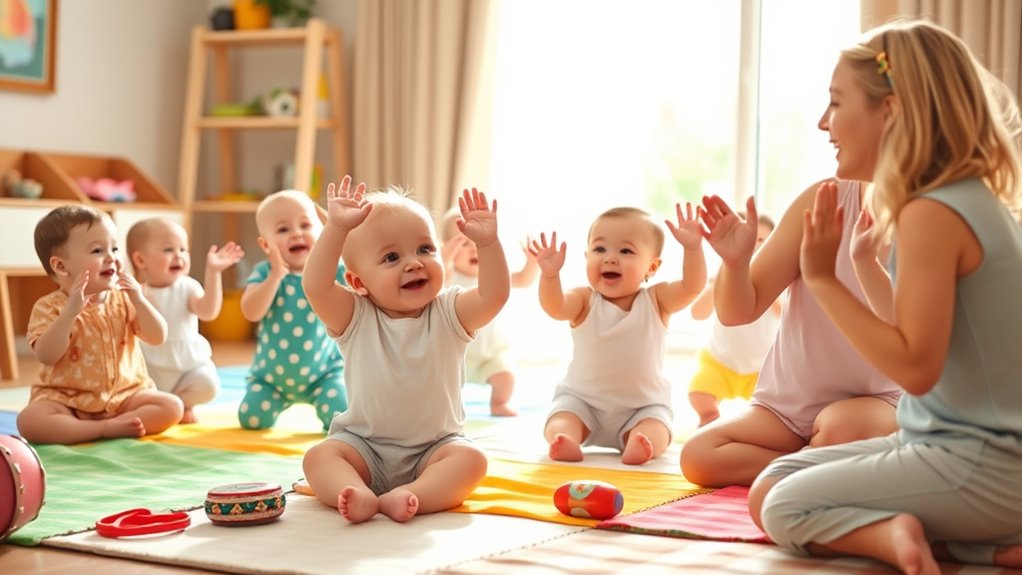
Music and movement play a vital role in a baby’s early development by stimulating their senses and encouraging physical activity. Engaging in music therapy helps boost cognitive skills, language, and emotional understanding, making early learning more enjoyable. As you introduce your baby to different sounds and rhythms, you’ll notice them reaching important musical milestones, like responding to a beat or mimicking simple sounds. These activities also promote motor skills, as your baby learns to dance, clap, or sway in time with music. Regular exposure to music and movement fosters a sense of rhythm and coordination, laying a strong foundation for future learning and social skills. Incorporating modern toys designed for musical interaction can further enhance their engagement and development. The increasing availability of extended hours at many stores can make it easier for parents to incorporate these activities into busy schedules, ensuring consistent engagement. Additionally, engaging in music and movement activities supports auditory processing development by helping babies differentiate between sounds and rhythms, which is essential for language acquisition. Creating opportunities for interactive play with musical instruments can also stimulate their sensory development, laying the groundwork for more complex cognitive skills. Overall, these experiences support your baby’s holistic growth and create joyful bonding moments.
Popular Songs to Get Your Baby Moving

To get your baby moving and engaged, choosing lively and simple songs is key. Songs like “The Wheels on the Bus” or “If You’re Happy and You Know It” encourage movement and joy. These tunes are often used in music therapy and dance classes for babies, fostering physical and emotional growth. When selecting songs, consider their rhythm and tempo to match your baby’s energy level. Engaging with familiar, upbeat music helps your little one develop a sense of rhythm and coordination. Plus, singing along and dancing together builds bonding and confidence. Remember, the goal is to make movement fun and natural, so keep it light and spontaneous. Incorporating music and movement benefits can further enhance your baby’s development and enjoyment. Using popular songs that are recommended for babies can make the experience even more enjoyable and beneficial. The right songs make a lasting impression and inspire your baby to move freely and happily.
Simple Dance Moves for Babies and Toddlers
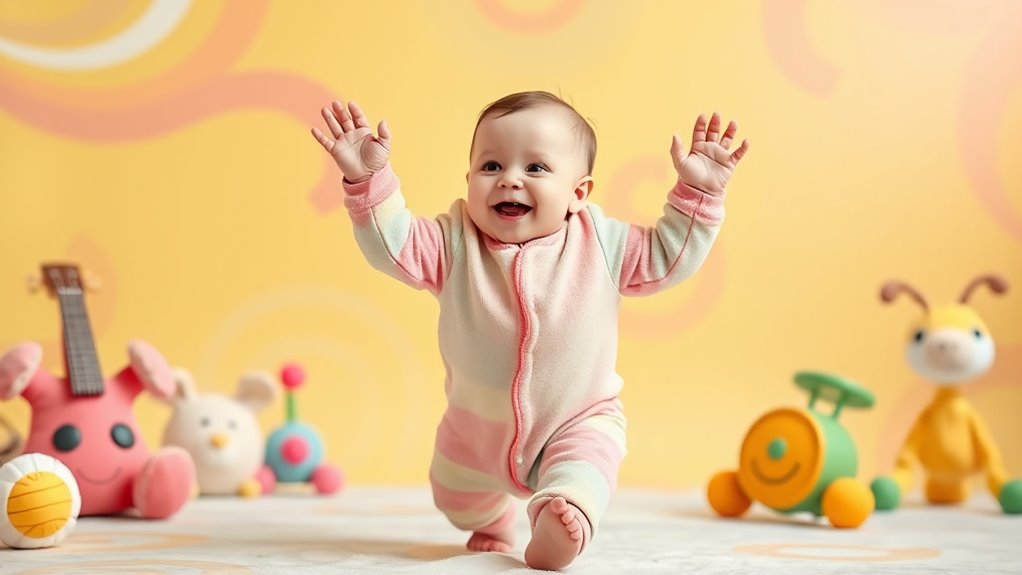
Introducing simple dance moves is a great way to help your baby or toddler develop coordination and enjoy movement. Start with clapping games, where you clap your hands together or with your little one to a catchy song. This encourages rhythm and hand-eye coordination. You can also introduce toe tapping by gently encouraging your child to tap their toes along to the beat. Keep the movements simple and fun, matching them to lively tunes. As your baby imitates your actions, they’ll build motor skills and confidence. Incorporating electric bikes into family outings can also inspire children to be curious about movement and energy. Engaging in developmentally appropriate activities helps foster a positive attitude toward physical activity. Exploring different crochet styles for locs can also stimulate a child’s interest in creative expression through movement, even passively. Being mindful of financial aspects related to activities and equipment can help ensure these experiences remain accessible and enjoyable for your family. Remember, the goal is to keep it lighthearted, encouraging your little one to explore movement and rhythm at their own pace. Incorporating age-appropriate music can further enhance engagement and make the experience more enjoyable.
Tips for Incorporating Music and Movement Into Daily Routines
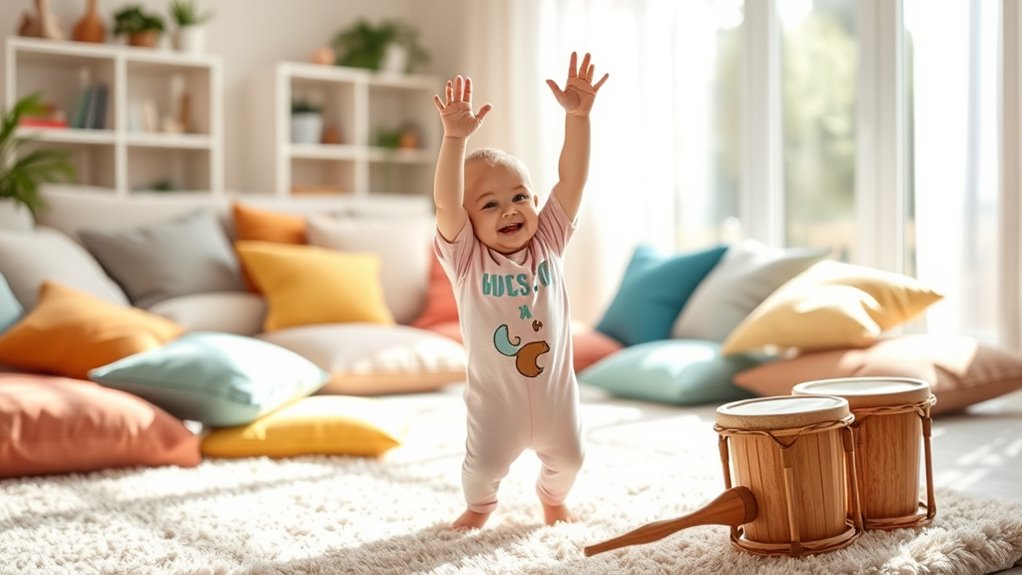
Incorporating music and movement into your daily routines can seamlessly enhance your little one’s development and enjoyment. Use musical storytelling during bath time or mealtime to make routines engaging and educational. Dressing up in fun dance costumes can turn ordinary moments into lively dance parties, encouraging your baby to move freely. Sing simple songs while tidying up toys or during diaper changes to build a routine that’s both fun and beneficial.
- Choose familiar tunes to create consistency and comfort
- Integrate dance costumes to inspire imaginative movement
- Use songs with storytelling elements to boost language skills
These tips make music and movement natural parts of your day, fostering a joyful environment that supports your baby’s growth.
Safety Guidelines for Active Play With Music

Before starting active play with music, make sure the play area is clear of hazards and clutter. Use movements that are appropriate for your baby’s age to keep them safe and comfortable. Staying attentive to these guidelines helps create a fun, secure environment for your little one. Incorporating safe sleep practices further ensures a protected setting. Additionally, being aware of essential oils for health can support overall well-being during active play.
Clear Play Area
Creating a clear play area is essential for safe active play with music. A well-organized space prevents accidents and encourages confident movement. When setting up your play area, focus on a clutter-free environment, ensuring there are no sharp edges or small objects that could cause harm. Proper play area setup also involves managing noise control to keep the environment comfortable and avoid overstimulation. Keep the area spacious enough for babies to move freely without fear of bumping into furniture or walls. Consider using soft mats or rugs to cushion falls and define the play zone. Remember, a tidy, well-planned space helps your baby enjoy music and movement safely and with confidence. Additionally, choosing appropriate furniture and decor can further reduce hazards and create a stimulating yet safe environment. Incorporating safety regulations into your setup ensures comprehensive protection during active play. Paying attention to decor styles that complement safety features can help foster a cheerful and secure play environment, especially when considering the compatibility of play areas with Vetted electric bike conversion kits and other outdoor equipment.
Age-Appropriate Movements
Understanding what movements are safe for your baby’s age is key to ensuring fun without risking injury. For infants, gentle activities like infant aerobics promote movement while keeping safety in mind. As your baby grows, introduce simple toddler dance moves that encourage balance and coordination, but avoid overly vigorous or complex actions. During active play with music, focus on movements that match your baby’s developmental stage. Keep movements slow and controlled for younger babies, and gradually increase activity as they gain strength and confidence. Always supervise closely, and watch for signs of fatigue or discomfort. Remember, safety comes first—don’t push your baby into movements they aren’t ready for. AI safety measures emphasize the importance of monitoring and adapting activities to your baby’s capabilities. Incorporating age-appropriate movements helps your little one enjoy active music sessions safely and happily. Additionally, understanding developmental milestones can guide you in selecting suitable movements that promote healthy growth.
Creative Ideas for Making Your Own Baby Music and Dance Activities
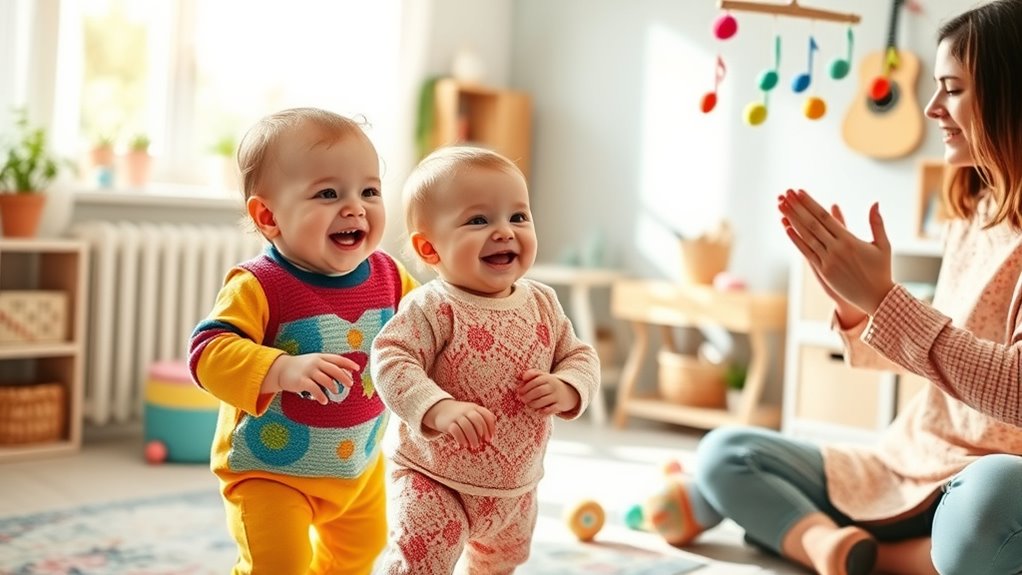
You can get creative by making simple instruments with household items or natural materials to engage your baby’s senses. Incorporate rhythmic movements and encourage your little one to move and groove along with the beat. Sing catchy songs with actions to make music time interactive and fun for both of you. To enhance the engagement, consider exploring color accuracy of your instruments and environment to make the experience more vibrant and stimulating.
DIY Instruments for Babies
Making your own baby-friendly instruments is a fun and safe way to introduce little ones to music and movement. DIY instruments, especially homemade percussion, are perfect for engaging babies’ senses and encouraging their natural rhythm. You can create simple, safe instruments using household items, allowing your baby to explore sounds freely. These homemade percussion tools foster sensory development and provide an interactive experience.
- Use empty containers like jars or tins filled with rice or beans to produce rhythmic sounds.
- Make shakers from plastic bottles sealed tightly, adding dried pasta or beads inside.
- Craft drums from cardboard boxes or sturdy cups with soft mallets for gentle tapping.
Creating DIY instruments encourages creativity, safe exploration, and early musical understanding for your baby.
Rhythmic Move and Groove
Engaging your baby in rhythmic movement and dance activities sparks their natural joy for music and helps develop their coordination. You can encourage clapping rhythms by clapping along with simple songs or creating your own beats to favorite tunes. This not only builds their sense of timing but also makes the activity fun and interactive. Incorporate musical storytelling by using expressive voices and gestures to bring songs or nursery rhymes to life, inspiring your baby to move in response. You might also improvise movements that match the rhythm, like bouncing or swaying, to deepen their understanding of musical patterns. These activities foster a love for music while strengthening their motor skills, making dance and rhythm a delightful part of your daily routine.
Sing-Alongs With Actions
Incorporating actions into sing-alongs can turn simple songs into lively, interactive experiences that boost your baby’s motor skills and musical understanding. Using interactive lyrics and hand gestures makes the activity engaging and memorable. When you add actions, your baby learns to connect words with movements, encouraging coordination and rhythm. You can create your own songs by choosing familiar tunes and adding simple gestures, like waving or clapping.
- Reinforces word and movement association, enhancing language skills
- Encourages body awareness and fine motor development
- Builds confidence through playful interaction and bonding
Frequently Asked Questions
How Can Music Support Language Development in Babies?
You can support your baby’s language development by encouraging activities that boost rhythm recognition and vocal imitation. Singing simple songs helps your baby tune into patterns and sounds, fostering early language skills. When you sing together, your baby practices copying your voice, strengthening vocal imitation. These interactions make learning fun and engaging, laying a foundation for future speech and communication skills. Keep it lively and interactive to maximize their progress.
What Are Signs of Overstimulation During Musical Activities?
You might notice signs of overstimulation during musical activities when your baby shows sensory overload, such as covering their ears or looking away. Fussiness during activities is another clue they’re overwhelmed. If your baby becomes irritable, restless, or stops engaging, it’s a good idea to pause and give them a break. Watch for these signs, and adjust the activity to keep it enjoyable and calming for your little one.
How Do Different Musical Genres Affect Babies’ Moods?
You might think all musical genres affect babies the same way, but their musical preferences and emotional responses vary. Upbeat, lively tunes can boost their happiness and energy, while gentle melodies soothe and calm them. Don’t worry about finding the perfect genre; observe your baby’s reactions and adapt accordingly. By exploring different styles, you help foster positive emotional responses and create joyful, engaging musical experiences tailored to their mood.
Can Music Influence Babies’ Sleep Patterns?
You might wonder if music can influence your baby’s sleep patterns. Yes, it can help establish sleep routines, making bedtime smoother. Soft, calming tunes, like lullabies, are often effective in soothing babies and promoting better sleep. Consistent use of such music before bedtime can signal it’s time to wind down, improving lullaby effectiveness and helping your baby settle more easily for sleep.
What Are Age-Appropriate Dance Activities for Toddlers?
Imagine your toddler’s energy as a bouncing ball—you want to keep it moving smoothly. Age-appropriate dance activities like toddler dance games and simple movement routines help channel that energy positively. You can encourage them to imitate animal movements or follow simple steps to lively tunes. These activities boost coordination and confidence, making dance a fun, healthy way for your little one to explore movement safely and joyfully.
Conclusion
Incorporating music and movement into your baby’s day boosts their development and strengthens your bond. Did you know that babies who engage in regular active play with music show improved motor skills and emotional well-being? By singing, dancing, and creating your own activities, you foster a joyful environment that encourages growth. So, keep the tunes flowing and the moves moving—your little one will thank you with giggles and newfound confidence!

